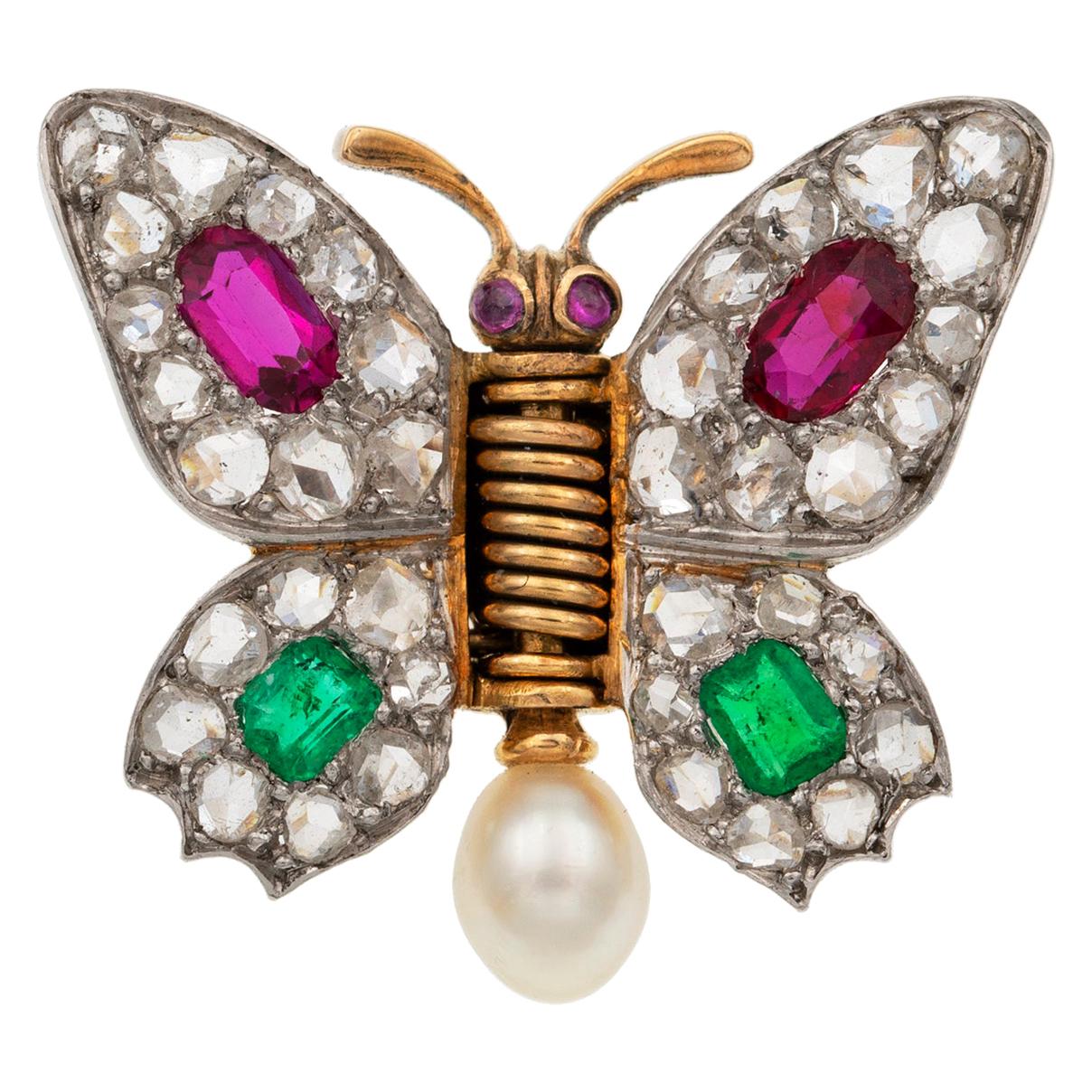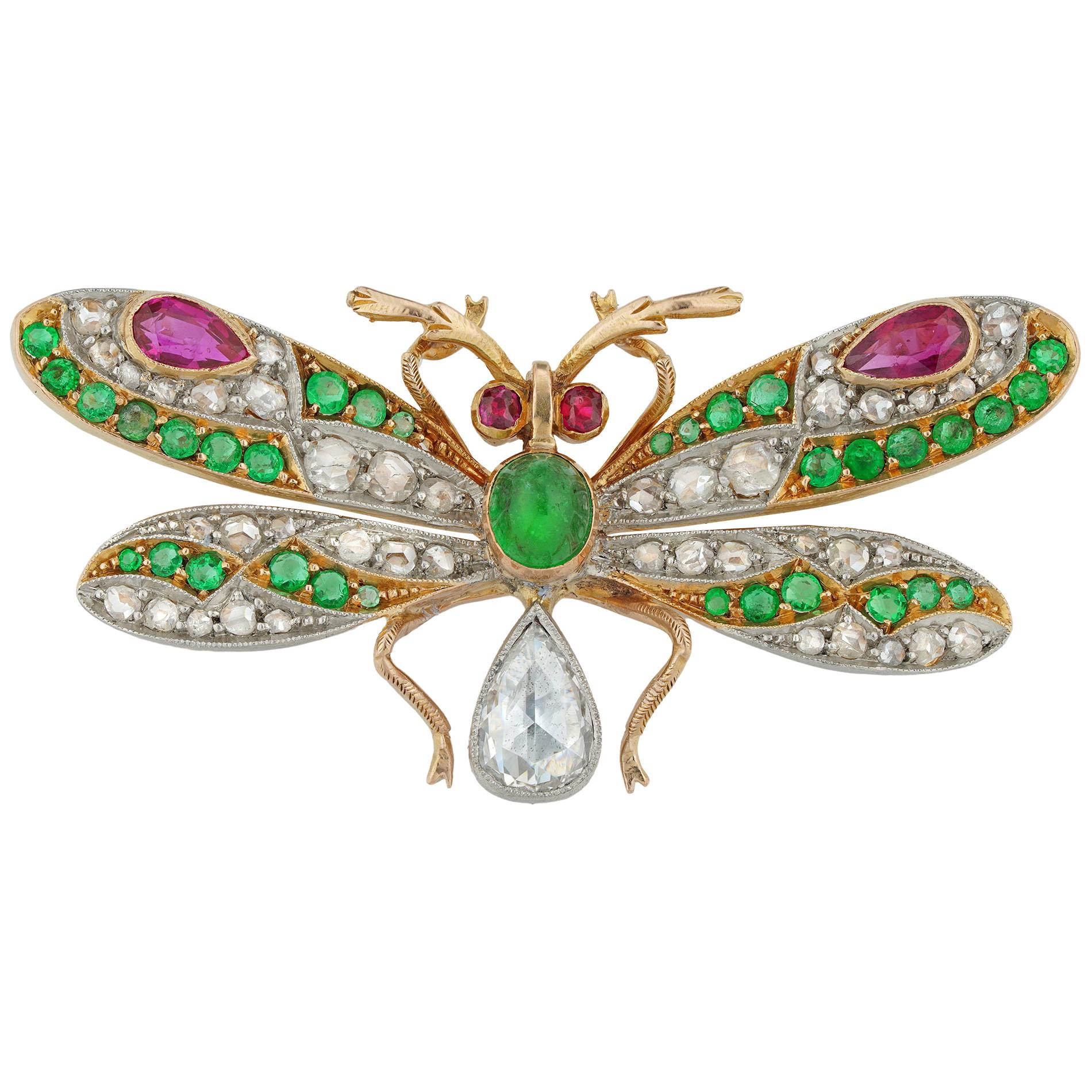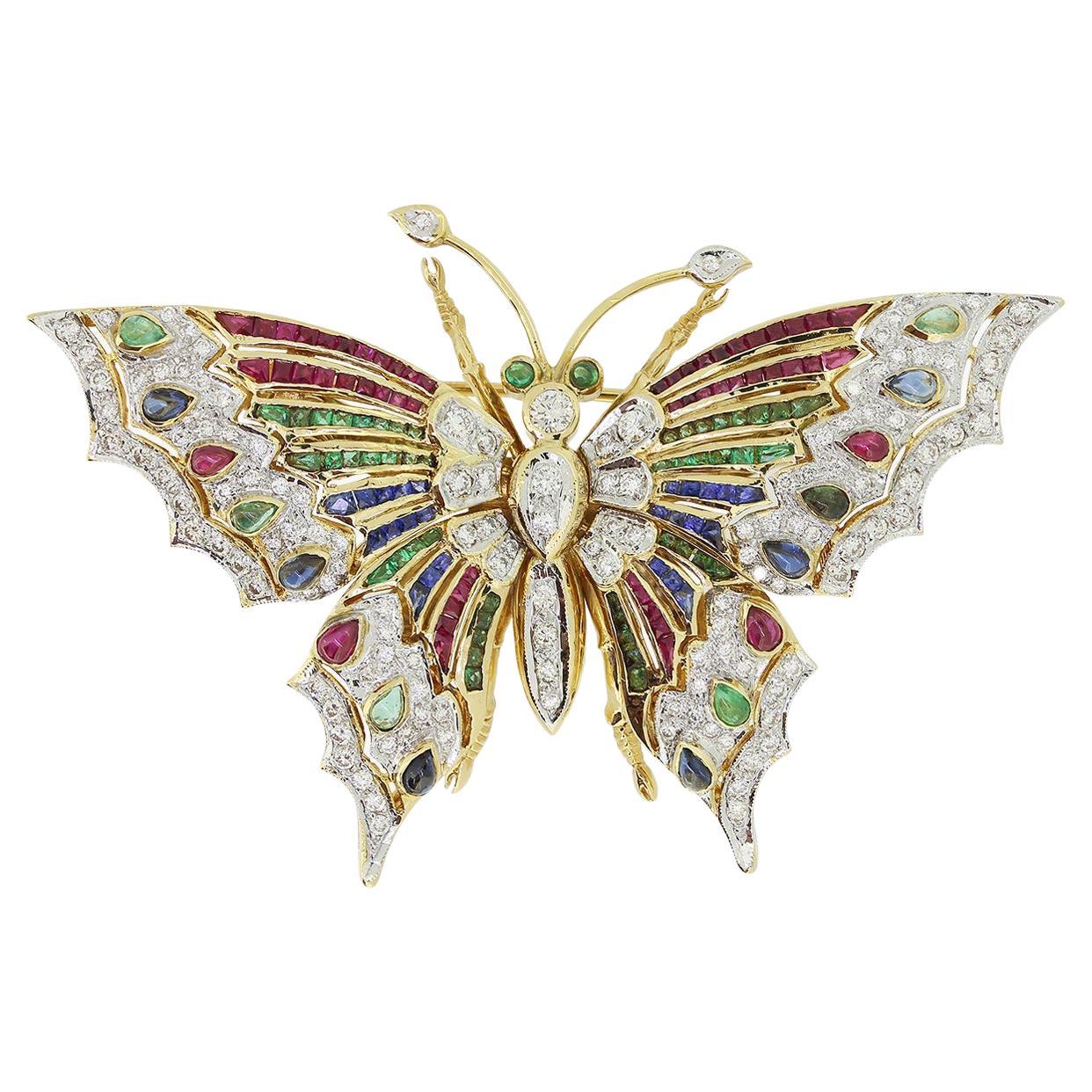Items Similar to Victorian Gem Set Butterfly Brooch/Pendant, Circa 1870.
Video Loading
Want more images or videos?
Request additional images or videos from the seller
1 of 6
Victorian Gem Set Butterfly Brooch/Pendant, Circa 1870.
About the Item
Victorian gem set butterfly brooch/pendant. Centrally set with a round old cut natural unenhanced ruby in a closed back cut-down setting with an approximate weight of 0.30 carats, additionally set with two round cabochon cut natural unenhanced rubies in closed back rubover settings with a combined weight of 0.06 carats, leading down to four natural saltwater button pearls in closed back grain settings graduating from 3.8-2.2mm in diameter, decorated further by four cushion shape old cut natural unenhanced sapphires in open back rubover and grain settings with a combined approximate weight of 0.90 carats, encircled by fifty eight cushion shape rose cut diamonds in open back grain settings with a combined approximate weight of 1.15 carats, to a finely modelled butterfly brooch featuring scalloped wings, legs and antennae extending from the central body body, intricately pierced with fancy shape open backholing, fitted to reverse with a secure pin and scroll clasp and fitted to top with a circular loop for suspension as a pendant, approximately 3cm in length. Tested yellow gold and silver, circa 1870.
- Metal:Yellow Gold,Silver
- Stone:Diamond,Natural Pearl,Ruby
- Stone Cut:Old European Cut
- Period:1870-1879
- Date of Manufacture:1870
- Condition:Wear consistent with age and use.
- Seller Location:London, GB
- Reference Number:
About the Seller
5.0
Recognized Seller
These prestigious sellers are industry leaders and represent the highest echelon for item quality and design.
1stDibs seller since 2011
56 sales on 1stDibs
Typical response time: 5 hours
- ShippingRetrieving quote...Ships From: London, United Kingdom
- Return PolicyThis item cannot be returned.
More From This SellerView All
- 1890s Pair of Victorian Gem Set Butterfly BroochesLocated in London, GBA pair of Victorian gem set butterfly brooches. A pair of brooches, set to the bodies with a cushion shape old mine natural unenhanced fancy colour pink...Category
Antique 1890s British Victorian Brooches
MaterialsBrown Diamond, Diamond, Emerald, Pink Diamond, Ruby, Gold
- Victorian diamond pendant/brooch, circa 1880.Located in London, GBVictorian diamond pendant/brooch. Centrally set with a cushion shape old mine diamond in an open back cut-down setting with an approximate we...Category
Antique 1880s Pendant Necklaces
MaterialsDiamond, Yellow Gold, Silver
- Victorian enamel bug brooch, Engish, circa 1890.Located in London, GBAntique enamel bug brooch. Set to centre with five round rose cut diamonds in closed back grain settings with an approximate combined weight of 0.05 carats,...Category
Antique 1890s Victorian Brooches
MaterialsDiamond, Natural Pearl, Ruby, Yellow Gold, Enamel
- Victorian Diamond and Enamel Snake Pendant, circa 1870Located in London, GBVictorian diamond and enamel snake pendant. Set to centre with a cushion shape old mine diamond in an open back cut-down setting with an approximate weight of 2.20 carats, further se...Category
Antique 1870s Pendant Necklaces
MaterialsDiamond, Yellow Gold, Silver, Enamel
- John Brogden Shell Cameo Brooch and Earrings, English, circa 1870By John BrogdenLocated in London, GBAntique shell cameo brooch and earrings by John Brogden, English, circa 1870. A yellow gold suite of jewellery, the brooch composed of a horizontally situated oval Bull’s Mouth shell cameo of the Greek goddess Selene riding a serpentine dragon in a rubover collet setting, encircled by a conforming frame of gold beading and twisted gold wire punctuated with four gold palmette form plaques engraved and decorated with dark blue enamel and placed at the cardinal points, the reverse mounted with a hinged pin and scroll clasp, the earrings each composed of a vertical oval Bull’s Mouth shell cameo engraved with a bust length portrait of Selene with crescent-set headdress, encircled by a conforming frame matching that of the brooch with the addition of a pendant decoration composed of a horizontal bar of gold beading and twisted gold wires suspending gold link chains graduated from centre and ending in conical gold elements, the reverses mounted with French wire fittings, all in a fitted red leather case, the interior marked ‘FIRST CLASS PARIS MEDAL/ 1855.1867.1851/ PARIS FIRST CLASS & LONDON PRIZE MEDALS/ JOHN BROGDON/ Goldsmith/ MANUFACTORY/ 16, Henrietta St. Covent Garden/ London’. The cameo—defined as a gem, usually either a mineral or a shell, upon which a design has been carved in relief—is believed to have originated in Hellenistic Greece, during the third century BC. These miniature sculptures, at that time confined to the medium of hardstone, are thought to have been made with the primary purpose of personal adornment. The same practice of mounting cameos in jewellery was then continued by the Ancient Romans, and they are known to have been worn by many a Roman emperor. After the fall of Rome the fashion for cameos went into a decline, until it was again revived during the Renaissance period, brought about by a keen interest in the ancient world. At this time both antique and contemporary cameos were mounted in jewellery, as well as collected as objet d’art. The art of cameo cutting was revived in Italy, where it would remain a centre for the coming centuries. Again there was a lull in interest in carved gemstones, until the Neoclassical revival of the eighteenth century, largely stimulated by the discoveries of the ancient Roman cities of Pompeii and Herculaneum. As with the Renaissance, antique specimens were generally prized over modern cameos, and the worldliest men in Europe held them among their collections of art and antiques. That said, carving centres in Rome and Torre del Greco (near Naples) in Italy were established in response to the demand of the Grand Tourists, who travelled to Italy and Greece to become educated in the wonders of the ancient world. It was at this time that shell cameos, mostly made in Torre del Greco due to its proximity to the sea, became more popular, owing to the relative ease in carving shell over hardstone. In addition to Rome, hardstone cameos also became a specialty of Idar Oberstein, Germany, which had a long history with both the gem mining and cutting trade. In a shift away from the collector’s cases of the previous century, the nineteenth century saw a strengthening in the fashion for wearable cameos. After the Empress Josephine donned a cameo-set suite of jewellery at the coronation of Napoleon in 1804, cameo jewellery became all the rage. Napoleon played a further hand in promoting the art by establishing a gemstone carving school in Paris, inspired by his appreciation for the arts of the ancient world. By the mid-nineteenth century shell cameos, in part due to their lightness compared with hardstone cameos, were the height of fashion. Large shell cameos as well as hardstone cameos were set into contemporary mounts, often as suites of jewellery. Some of the best cameos of the nineteenth century—carved by a select group of recognized carvers—were set into revivalist mounts, corresponding to the subject matter. In Victorian England cameo jewellery was particularly prized, due in part to the fact that the Queen owned and wore a number of cameo jewels. One example which can often be seen in official portraits is the Badge of the Order of Victoria and Albert, carved by Tommaso Saulini of Rome, who also produced cameos for the maker of the present suite, John Brogden. To meet demand some carvers set themselves up in London, including William Schmidt, a German carver from Idar Oberstein, who produced cameos for top London jewellers, including Brogden, Carlo Giuliano and Child & Child. In fact, Schmidt purports to have been the first to carve cameos out of opal, which Brogden reportedly displayed in the Paris Exhibition of 1878. An extant example, now in the collection of the British Museum, was set by the Giuliano firm. Regarding subject matter, cameos throughout time have been largely figural, from bust length profile portraits to scenes with multiple full-length figures, and sometimes animals. Ancient Greek and Roman cameos often depicted mythological scenes as well as contemporary figures. During the Renaissance, mythological scenes were popular, often taken directly from ancient sculpture, as well as portraits of notable contemporary figures. During the eighteenth and nineteenth centuries, due to the revivalist styles, both Renaissance and Classical subjects were copied and set into matching (and sometimes unmatching) revivalist mounts. From the Renaissance through the Victorian era, being able to recognize the source of the carving in a cameo was a mark of erudition, revealing in the wearer knowledge of Classical art. As mentioned, the present cameo parure...Category
Antique 1870s English Victorian Brooches
MaterialsYellow Gold
- Victorian amethyst and citrine brooch, circa 1860.Located in London, GBVictorian amethyst and citrine brooch. Set to centre with one round old cut citrine in an open back claw setting with an approximate weight of 60 carats, encircled by four round old ...Category
Antique 1860s Brooches
MaterialsAmethyst, Citrine, Yellow Gold
You May Also Like
- Late Victorian Gem-Set Butterfly BroochLocated in London, GBA late Victorian gem-set butterfly brooch, the body is a gold spring terminating to a natural pearl, the eyes set with two cabochon-cut rubies, th...Category
Antique 1890s French Art Nouveau Brooches
MaterialsDiamond, Emerald, Natural Pearl, Ruby, 18k Gold, Platinum
- A Victorian Gem-set Butterfly BroochLocated in London, GBA Victorian gem-set butterfly brooch, the body set with old-cut diamonds, the wings embellished with rose and old-cut diamonds, emeralds and rubies, perched on a branch with rose-cut diamond-set leaves, all mounted in yellow gold, the detachable butterfly can be worn individually as a brooch, accompanied by associated fitting, circa 1880, unmarked, tested as 18ct gold, measuring 4.3 2.7cm, gross weight 10.8 grams. This antique brooch is in very good condition for its age. Unmarked, tested as 18ct gold. This colourful and bright Victorian butterfly brooch comes from the collection of Bentley and Skinner, the London jewellers by appointment to both Her Majesty the Queen and His Royal Highness the Prince of Wales. This brooch features a yellow gold floral branch set with sparkling rose-cut diamonds. Resting on the branch is a butterfly set with further rose-cut and old European cut diamonds and decorated with bright and vivid rubies and emeralds. This charming brooch...Category
Antique Late 19th Century English Victorian Brooches
Materials18k Gold
- Late Victorian Gem-Set Butterfly BroochLocated in London, GBA late Victorian gem-set butterfly brooch, the thorax with a round cabochon emerald, the abdomen with a pear-shaped rose-cut diamond estimated to weigh 0.6 carats, the eyes set with round faceted rubies, and the wings embellished with faceted emeralds, rose-cut diamonds and two pear-shaped rubies, all millegrain-set in platinum and yellow gold mount, with gold brooch fitting, circa 1900, measuring 4.5 x 2.2 cm, gross weight 9.9 grams. This antique brooch is in very good condition for its age. Unmarked tested as 18ct gold and platinum. This beautiful late Victorian butterfly brooch...Category
Antique Late 19th Century British Late Victorian Brooches
MaterialsDiamond, Emerald, Ruby, 18k Gold, Platinum
- Late Victorian Multi-Gem Butterfly BroochLocated in London, GBA late Victorian multi-gem butterfly brooch, the wings and body encrusted with old-cut and rose-cut diamonds, highlighted with demantoid garnets, and rubies, with cabochon-cut sapphire eyes, set in silver to a yellow gold mount and brooch fitting, circa 1890, measures approximately 3x1.3cm, gross weight 3.1 grams. This antique brooch is in very good condition for its age. Unmarked, tested as 18ct gold and silver, with later 18ct gold clasp. This colourful and delicate Victorian butterfly brooch...Category
Antique 1890s British Late Victorian Brooches
MaterialsDiamond, Garnet, Ruby, Sapphire, Yellow Gold, Silver
- Vintage Gem-Set Butterfly BroochLocated in London, GBHere we have a vibrant gem set brooch from the 1970s. This vintage piece has been crafted from 18ct yellow gold into the shape of a butterfly with distinct channels milgrain set with...Category
Vintage 1970s Brooches
MaterialsDiamond, Emerald, Ruby, Sapphire, Blue Sapphire, Gold, Yellow Gold
- 19th Century Gem-Set Butterfly BroochLocated in Firenze, ITThe circular-cut sapphire and ruby, pear shaped aquamarine the openwork wings pavé-set with gem-set, the antennae with emerald, mounted in silver and gold, width 4.7cm Weight:10.66gr.Category
Antique 1870s Italian Brooches
MaterialsRuby, Sapphire, Aquamarine, 18k Gold, Yellow Gold, Silver
Recently Viewed
View AllMore Ways To Browse
Antique Setting
Victorian Jewellery Set
Victorian Jewlery Set
Butterfly Jewelry Set
European Cut Gem
Antique Gem Cuts
Diamond Set Butterfly
Old European Cut Gem
Butterfly Pearl
Butterfly Brooches
Butterfly Gem
Scroll Brooch
Victorian Diamond Brooch Pendant
Antique Button Jewellery
Antique Button Jewelry
Victorian Cabochon Brooch
Victorian Ruby Brooch
Open Back Brooch





